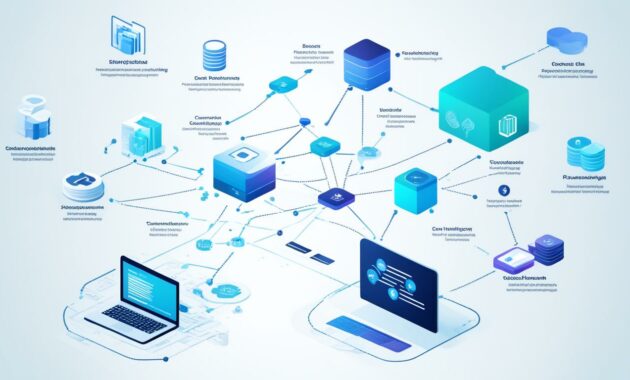Welcome to our article on business intelligence technologies! In today’s competitive landscape, harnessing the power of data analysis has become crucial for businesses. That’s where business intelligence technologies come into play. These cutting-edge tools can revolutionize your data analysis, providing you with powerful insights for informed decision-making.
At [Company Name], we understand the importance of staying ahead of the competition. By leveraging the potential of business intelligence technologies, you can gain a competitive edge and drive the success of your business.
In this article, we will delve into the leading business intelligence technologies that can transform raw data into actionable information. From data visualization and reporting tools to advanced analytics and machine learning techniques, we will explore the vast array of options available for your organization.
So, if you’re ready to unlock valuable insights and simplify your data analysis process, join us as we explore the world of business intelligence technologies. Let’s dive in!
Understanding Business Intelligence Technologies
Business intelligence technologies have revolutionized the way organizations analyze and interpret data. Before exploring the specific technologies, it’s important to grasp the fundamentals of business intelligence and its benefits for businesses.
At its core, business intelligence involves transforming raw data into actionable information that can drive informed decision-making. By using cutting-edge technologies, businesses can gain valuable insights, identify trends, and uncover opportunities for growth.
Business intelligence technologies encompass a range of tools and techniques that enable organizations to extract meaningful insights from vast amounts of data. These technologies streamline data collection, analysis, and reporting, making it easier to identify patterns, make predictions, and optimize business operations.
The Role of Business Intelligence Technologies
Business intelligence technologies play a crucial role in gathering, consolidating, and visualizing data from disparate sources. They provide a comprehensive overview of critical metrics, enabling stakeholders to make data-driven decisions across various departments and functions.
By leveraging business intelligence technologies, organizations can:
- Track and measure key performance indicators (KPIs) to monitor the success of business strategies.
- Identify trends and patterns in customer behavior to improve customer satisfaction and retention.
- Optimize supply chain and inventory management processes to reduce costs and increase operational efficiency.
- Forecast sales and demand to facilitate better production planning and resource allocation.
With business intelligence technologies, organizations can break down complex data into visually appealing dashboards, charts, and reports. This presents information in a user-friendly format, enabling stakeholders at all levels to understand and interpret data effectively.
Benefits of Business Intelligence Technologies
The adoption of business intelligence technologies offers numerous benefits for organizations, including:
- Improved Decision-Making: Business intelligence technologies provide accurate, up-to-date insights that support strategic decision-making.
- Increased Efficiency: Automation and streamlined data processes save time and resources, allowing teams to focus on analysis and strategy.
- Enhanced Competitiveness: Access to real-time data and insights enables organizations to stay ahead of the competition and identify new market opportunities.
- Better Customer Understanding: By analyzing customer data, organizations can gain a deeper understanding of their audience, personalize offerings, and improve customer satisfaction.
- Identifying Cost Savings: Business intelligence technologies can help identify areas of wastage, inefficiency, and cost reduction opportunities.
Understanding the fundamentals and benefits of business intelligence technologies sets the stage for exploring specific tools and techniques that can further support data analysis and decision-making. In the next sections, we will delve into data visualization, advanced analytics, and cloud-based solutions that are revolutionizing the business intelligence landscape.

Data Visualization and Reporting Tools
When it comes to analyzing complex data, visualization plays a crucial role in making it understandable and accessible. Data visualization is the process of representing data visually through charts, graphs, and interactive dashboards, allowing businesses to gain valuable insights at a glance.
By using data visualization and reporting tools, businesses can present their findings in a visually appealing and engaging manner, making it easier for stakeholders to understand and interpret the information. These tools provide a comprehensive view of data, allowing users to spot trends, patterns, and outliers effortlessly. With the help of interactive features, users can drill down into specific data points, explore different dimensions, and gain a deeper understanding of their business metrics.
One popular data visualization tool is Tableau, known for its user-friendly interface and powerful capabilities. Tableau allows users to create a wide range of visualizations, from basic bar charts to intricate network diagrams. Additionally, it offers interactive dashboards that enable users to explore data in real-time, filtering and highlighting relevant information based on their needs.
Another widely used tool is Power BI, part of the Microsoft suite of business intelligence tools. Power BI provides users with a seamless experience in creating visually stunning reports and dashboards. With its drag-and-drop interface and extensive library of visualizations, users can effortlessly transform raw data into meaningful insights.

Benefits of Data Visualization and Reporting Tools:
- Improved Data Interpretation: Data visualization helps users quickly understand complex data sets, making it easier to identify trends, correlations, and outliers.
- Enhanced Decision-Making: Visual representations make it easier to identify opportunities and make informed decisions based on data-driven insights.
- Increased Stakeholder Engagement: Visualizations make it easier for stakeholders to understand and interact with data, leading to more meaningful and productive discussions.
- Efficient Report Creation and Automation: Reporting tools streamline the process of creating reports, saving time and effort. They also allow for automation, ensuring data is always up-to-date.
- Improved Collaboration: Data visualization and reporting tools enable teams to collaborate effectively by sharing interactive dashboards and reports, fostering a data-driven culture within the organization.
By incorporating data visualization and reporting tools into their business intelligence stack, organizations can unlock the full potential of their data and make data-driven decisions with confidence. Whether it’s Tableau, Power BI, or other similar tools, the key lies in choosing the right tool that aligns with your specific business needs, empowering you to turn data into actionable insights.
Advanced Analytics and Machine Learning
In today’s data-driven world, businesses need powerful tools to unlock hidden patterns and gain valuable insights from their data. Advanced analytics and machine learning techniques are revolutionizing the way organizations analyze and make decisions based on their data.
Advanced analytics involves the use of sophisticated algorithms and statistical models to uncover patterns, correlations, and trends that may go unnoticed with traditional analytics methods. By applying advanced analytics techniques, businesses can gain a deeper understanding of their data and make informed decisions that drive growth and optimize performance.
Machine learning, a subset of artificial intelligence, takes data analysis to a whole new level. By training machines to learn from data and make predictions or take actions based on patterns and algorithms, businesses can automate decision-making processes and achieve precise results. Machine learning algorithms can identify trends, classify data, detect anomalies, and make accurate predictions, helping organizations improve operational efficiency and provide personalized experiences to their customers.
One of the key benefits of advanced analytics and machine learning is their ability to handle large and complex datasets. Businesses today collect vast amounts of data from various sources, such as customer interactions, website analytics, social media, and IoT devices. With advanced analytics and machine learning tools, organizations can process and analyze these massive datasets more efficiently, extracting valuable insights and discovering hidden opportunities.
Leading businesses are leveraging advanced analytics and machine learning techniques to optimize a wide range of operations. From predictive maintenance in manufacturing to fraud detection in finance, these technologies are transforming industries and driving innovation.
- Improved demand forecasting: Advanced analytics and machine learning algorithms can analyze historical sales data, market trends, and external factors to predict future demand accurately. This enables businesses to optimize their inventory management, reduce costs, and improve customer satisfaction by ensuring the availability of products when and where they are needed.
- Enhanced customer segmentation: Advanced analytics can analyze customer data, such as demographics, purchase behavior, and online interactions, to create detailed customer profiles and segmentations. By understanding their customers’ preferences and needs, businesses can personalize their marketing strategies and deliver targeted offers, ultimately improving customer satisfaction and loyalty.
- Optimized pricing strategies: Machine learning algorithms can analyze market dynamics, competitor pricing, and customer behavior to recommend optimal pricing strategies in real-time. This allows businesses to maximize revenue and profitability while staying competitive in dynamic markets.
- Efficient supply chain management: Advanced analytics can analyze supply chain data, including logistics, inventory, and transportation, to identify bottlenecks, optimize routes, and streamline operations. Businesses can minimize costs, improve delivery times, and ensure the smooth flow of goods and services.
By embracing advanced analytics and machine learning, businesses can gain a competitive edge by making data-driven decisions and unlocking valuable insights from their data. These technologies are reshaping industries and empowering organizations to achieve growth and success in today’s fast-paced and data-rich business environment.
Cloud-Based Business Intelligence Solutions
When it comes to harnessing the power of data, cloud-based business intelligence solutions are revolutionizing the way organizations extract insights and make informed decisions. By leveraging the capabilities of the cloud, businesses can access their data anytime, anywhere, and from any device, eliminating the need for on-premises infrastructure and providing unparalleled scalability.
One of the key advantages of cloud-based business intelligence solutions is their inherent flexibility. With cloud deployments, organizations can easily scale their resources up or down based on their needs, allowing them to adapt to changing business requirements without the limitations of traditional infrastructure. As data volumes grow, the cloud can effortlessly accommodate the increased demand for storage and processing power, ensuring that businesses can seamlessly handle large datasets and complex analytics tasks.
Real-time access to data is another significant benefit offered by cloud-based business intelligence solutions. In today’s fast-paced business environment, decisions need to be made quickly and based on the most up-to-date information. Cloud deployments enable organizations to access real-time data, ensuring that insights and reports are always current. This is particularly valuable for agile decision-making, allowing businesses to respond rapidly to market changes and stay ahead of the competition.
Collaborative Analytics and Secure Data Storage
Collaboration is a critical aspect of effective data analysis and decision-making. Cloud-based business intelligence solutions provide collaborative analytics capabilities, allowing multiple team members to work on the same dataset simultaneously. This fosters collaboration, data sharing, and cross-functional insights, enabling organizations to leverage the collective knowledge and expertise of their teams.
Furthermore, cloud deployments prioritize data security and privacy. Leading cloud-based business intelligence platforms implement robust security measures to protect sensitive information, such as encryption, access controls, and regular audits. This ensures that data remains secure throughout its lifecycle, from storage to transmission and analysis.
By embracing cloud-based business intelligence solutions, organizations can unlock the true potential of their data, driving innovation, and gaining a competitive edge. With scalability, flexibility, real-time access, collaborative analytics, and secure data storage, the cloud is transforming the way businesses analyze data and make informed decisions.
Conclusion
In conclusion, adopting the right business intelligence technologies can unlock valuable insights, simplify data analysis, and enhance decision-making processes. By harnessing the power of these cutting-edge tools, businesses can stay competitive in today’s data-driven world and drive the success of their operations.
With business intelligence technologies, organizations can make data-driven decisions that align with their strategic goals. These tools enable them to gather, analyze, and visualize data in a meaningful way, providing valuable insights that can lead to improved operational efficiency, streamlined processes, and better customer experiences.
Furthermore, the adoption of business intelligence technologies empowers businesses to stay ahead of the curve in an increasingly complex and competitive landscape. These tools facilitate the identification of emerging trends, market opportunities, and potential risks, allowing organizations to make informed decisions and adapt to ever-changing business dynamics.
In today’s fast-paced digital era, leveraging the power of business intelligence technologies is no longer a luxury but a necessity. By embracing these innovative solutions, businesses can gain a crucial competitive advantage, drive growth, and ensure long-term success in their respective industries.
